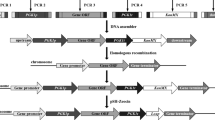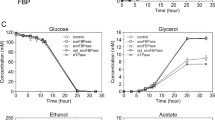Abstract
Flavor production by esters or by higher alcohols play a key role in the sensorial quality of fermented alcoholic beverages. In Saccharomyces cerevisiae cells, the syntheses of esters and higher alcohols are considerably influenced by intracellular CoA levels catalyzed by pantothenate kinase. In this work, we examined the effects of cofactor CoA and acetyl-CoA synthesis on the metabolism of esters and higher alcohols. Strains 12α−BAP2 and 12α+ATF1 where generated by deleting and overexpressing BAP2 (encoded branched-chain amino acid permease) and ATF1 (encoded alcohol acetyl transferases), respectively, in the parent 12α strains. Then, 12α−BAP2+CAB1 and 12α−BAP2+CAB3 strains were obtained by overexpressing CAB1 (encoded pantothenate kinase Cab1) and CAB3 (encoded pantothenate kinase Cab3) in the 12α−BAP2 strain, and 12α−BAP2+CAB1+ATF1 and 12α−BAP2+CAB3+ATF1 were generated by overexpressing ATF1 in the pantothenate kinase overexpression strains. The acetate ester level in 12α−BAP2 was slightly changed relative to that in the control strain 12α, whereas the acetate ester levels in 12α−BAP2+CAB1, 12α−BAP2+CAB3, 12α−BAP2+CAB1+ATF1, and 12α−BAP2+CAB3+ATF1 were distinctly increased (44–118% for ethyl acetate and 18–57% for isoamyl acetate). The levels of n-propanol, methyl-1-butanol, isopentanol, isobutanol, and phenethylol levels were changed and varied among the six engineered strains. The levels of acetate esters and higher alcohols can be modulated by changing the CoA and acetyl-CoA levels. The method proposed in this work supplies a practical means of breeding yeast strains by modulating acetate ester and higher alcohol production.


Similar content being viewed by others
References
Berríos-Rivera SJ, San KY, Bennett GN (2003) The effect of carbon sources and lactate dehydrogenase deletion on 1,2-propanediol production in Escherichia coli. J Ind Microbiol Biotechnol 30(1):34–40
Berrı́os-Rivera SJ, San KY, Bennett GN (2002) The effect of NAPRTase overexpression on the total levels of NAD, the NADH/NAD+ratio, and the distribution of metabolites in Escherichia coli. Metab Eng 4(3):238–247
Boynton ZL, Bennett GN, Rudolph FB (1994) Intracellular concentrations of coenzyme A and its derivatives from Clostridium acetobutylicum ATCC 824 and their roles in enzyme regulation. Appl Environ Microbiol 60(1):39–44
Chohnan S, Izawa H, Nishihara H, Takamura Y (1998) Changes in size of intracellular pools of coenzyme A and its thioesters in Escherichia coli K-12 cells to various carbon sources and stresses. J Agric Chem Soc Jpn 62(6):1122–1128
Chohnan S, Furukawa H, Fujio T, Nishihara H, Takamura Y (1997) Changes in the size and composition of intracellular pools of nonesterified coenzyme A and coenzyme A thioesters in aerobic and facultatively anaerobic bacteria. Appl Environ Microbiol 63(2):553–560
Cordente AG, Swiegers JH, Hegardt FG, Pretorius IS (2010) Modulating aroma compounds during wine fermentation by manipulating carnitine acetyltransferases in Saccharomyces cerevisiae. FEMS Microbiol Lett 267(2):159–166
Denman AM (1983) Molecular cloning: a laboratory manual. Immunology 49(2):411
Dickinson JR, Lanterman MM, Danner DJ, Pearson BM, Sanz P, Harrison SJ, Hewlins MJ (1997) A 13C nuclear magnetic resonance investigation of the metabolism of leucine to isoamyl alcohol in Saccharomyces cerevisiae. J Biol Chem 272(43):26871–26878
Dong J, Hong KQ, Hao AL, Zhang CY, Fu XM, Wang PF, Xiao DG (2018) Gradual enhancement of ethyl acetate production through promoter engineering in chinese liquor yeast strains. Biotechnol Prog 34(76):328–336
Felix E (1904) Ueber das natürliche isomere des leucins. Berichte Der Deutschen Chemischen Gesellschaft 37:1809–1840
Fujii T, Yoshimoto H, Nagasawa N, Bogaki T, Tamai Y, Hamachi M (1996) Nucleotide sequences of alcohol acetyltransferase genes from lager brewing yeast, Saccharomyces carlsbergensis. Yeast 12(6):593–598
Fujii T, Yoshimoto H, Tamai Y (1996) Acetate ester production by Saccharomyces cerevisiae lacking the ATF1 gene encoding the alcohol acetyltransferase. J Ferment Bioeng 81(6):538–542
Gietz RD, Akio S (1988) New yeast-Escherichia coli shuttle vectors constructed with in vitro mutagenized yeast genes lacking six-base pair restriction sites. Gene 74(2):527–534
Gietz RD, Schiestl RH, Willems AR, Woods RA (2010) Studies on the transformation of intact yeast cells by the LiAc/SS-DNA/PEG procedure. Yeast 11(4):355–360
Grauslund M, Didion T, Kielland-Brandt MC, Andersen HA (1995) BAP2, a gene encoding a permease for branched-chain amino acids in Saccharomyces cerevisiae. (Biochimica et Biophysica Acta (BBA)) Mol Cell Res 1269(3):275–280. https://doi.org/10.1016/0167-4889(95)00138-8
Krivoruchko A, Serrano-Amatriain C, Chen Y, Siewers V, Nielsen J (2013) Improving biobutanol production in engineered Saccharomyces cerevisiae by manipulation of acetyl-CoA metabolism. J Ind Microbiol Biotechnol 40(9):1051–1056
Leonardi R, Zhang YM, Rock CO, Jackowski S (2005) Coenzyme A: back in action. Prog Lipid Res 44(2):125–153
Li H (2013) Development of a microbial process for the conversion of carbon dioxide and electricity to higher alcohols as biofuels. Dissertations & Theses—Gradworks
Lilly M, Lambrechts MG, Pretorius IS (2000) Effect of increased yeast alcohol acetyltransferase activity on flavor profiles of wine and distillates. Appl Environ Microbiol 66(2):744–753
Lilly M, Bauer FF, Lambrechts MG, Swiegers JH, Cozzolino D, Pretorius IS (2010) The effect of increased yeast alcohol acetyltransferase and esterase activity on the flavour profiles of wine and distillates. Yeast 23(9):641–659
Livak KJ, Schmittgen TD (2001) Analysis of relative gene expression data using real-time quantitative PCR and the \(2^{{ - \Delta \Delta C_{\text{t}} }}\) method. Methods 25(4):402–408. https://doi.org/10.1006/meth.2001.1262
Lv X, Xie W, Lu W, Guo F, Gu J, Yu H, Ye L (2014) Enhanced isoprene biosynthesis in Saccharomyces cerevisiae by engineering of the native acetyl-CoA and mevalonic acid pathways with a push–pull-restrain strategy. J Biotechnol 186:128–136
Machado HB, Dekishima Y, Hao L, Lan EI, Liao JC (2012) A selection platform for carbon chain elongation using the CoA-dependent pathway to produce linear higher alcohols. Metab Eng 14(5):504–511
Matthew D, Boris P, Michael F, Michael S, Athanasios L, Valerie CL, Andrei O (2002) Complete reconstitution of the human coenzyme A biosynthetic pathway via comparative genomics. J Biol Chem 277(24):21431–21439
Mori H, Onishi H (1967) Diploid hybridization in a heterothallic haploid yeast, Saccharomyces rouxii. Appl Microbiol 15(4):928
Olzhausen J, Moritz T, Neetz T, Schüller HJ (2013) Molecular characterization of the heteromeric coenzyme A–synthesizing protein complex (CoA–SPC) in the yeast Saccharomyces cerevisiae. FEMS Yeast Res 13(6):565–573
Olzhausen J, Schubbe S, Schüller HJ (2009) Genetic analysis of coenzyme A biosynthesis in the yeast Saccharomyces cerevisiae: identification of a conditional mutation in the pantothenate kinase gene CAB1. Curr Genet 55(2):163–173
Schadeweg V, Boles E (2016) Increasing n-butanol production with Saccharomyces cerevisiae by optimizing acetyl-CoA synthesis, NADH levels and trans-2-enoyl-CoA reductase expression. Biotechnol Biofuels 9(1):257
Stolz J, Sauer N (1999) The fenpropimorph resistance gene FEN2 from Saccharomyces cerevisiae encodes a plasma membrane H+-pantothenate symporter. J Biol Chem 274(26):18747
Vadali RV, Bennett GN, San KY (2004) Applicability of CoA/acetyl-CoA manipulation system to enhance isoamyl acetate production in Escherichia coli. Metab Eng 6(4):294–299
Vadali RV, Bennett GN, San KY (2004) Cofactor engineering of intracellular CoA/acetyl-CoA and its effect on metabolic flux redistribution in Escherichia coli. Metab Eng 6(2):133–139
Hunter WW, Skatrud PL, Zhixiong X, Toyn JH (2003) Specialization of function among aldehyde dehydrogenases: the ALD2 and ALD3 genes are required for beta-alanine biosynthesis in Saccharomyces cerevisiae. Genetics 163(1):69–77
Wenlai F, Qian MC (2005) Headspace solid phase microextraction and gas chromatography-olfactometry dilution analysis of young and aged Chinese “Yanghe Daqu” liquors. J Agric Food Chem 53(20):7931–7938
Wu Q, Kong Y, Xu Y (2015) Flavor profile of Chinese liquor is altered by interactions of intrinsic and extrinsic microbes. Appl Environ Microbiol 82(2):422
Zengyi S, Hua Z, Huimin Z (2009) DNA assembler, an in vivo genetic method for rapid construction of biochemical pathways. Nucleic Acids Res 37(2):e16
Acknowledgements
This work is supported by the National Natural Science Foundation of China, NSAF Joint Fund (31671838), NSAF (21576200) National Natural Science Foundation of China (31471724).
Author information
Authors and Affiliations
Corresponding author
Ethics declarations
Conflict of interest
The authors declare that they have no conflict of interest.
Ethical approval
This article does not contain any studies with human participants or animals performed by any of the authors.
Additional information
Publisher's Note
Springer Nature remains neutral with regard to jurisdictional claims in published maps and institutional affiliations.
Electronic supplementary material
Below is the link to the electronic supplementary material.
Rights and permissions
About this article
Cite this article
Hong, KQ., Fu, XM., Dong, SS. et al. Modulating acetate ester and higher alcohol production in Saccharomyces cerevisiae through the cofactor engineering. J Ind Microbiol Biotechnol 46, 1003–1011 (2019). https://doi.org/10.1007/s10295-019-02176-4
Received:
Accepted:
Published:
Issue Date:
DOI: https://doi.org/10.1007/s10295-019-02176-4




